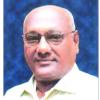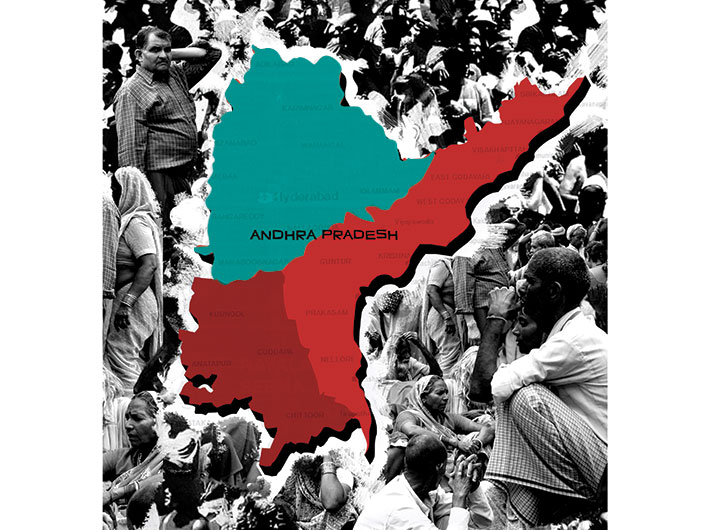That would be the logical conclusion of Telangana proponents’ argument of taking ‘sentiment’ into account and divide Andhra Pradesh
Over two centuries of the Asaf Jahi rule [from 1724 to 1947] of the Deccan created a cultural divide among the Telugu speaking people. While the Telugu people of the coastal and Rayalaseema districts progressed in economic, educational and cultural fields under the British rule, their brethren in Nizam’s territories were subjected to exploitation and a primitive rule.
Their language was suppressed – people could use only Urdu or Marathi in public discourse – and a process of acculturation took place in the name of ‘Hyderabadi’ culture which came to largely rely on the language, culture and even cuisine of north India, almost to the exclusion of the local language and culture. Induru became Nizamabad; Palamuru came to be called Mahabubnagar; Elagandala was renamed Karimnagar; Eedulakanti, a village near Hyderabad, was given a new name, Inder-Karan; a host of native names have been mutilated or replaced by outlandish names.
ALSO READ: After Telangana, a case for separate state of Mumbai
An impression was sought to be created that the history of Telangana began with the Qutb-Shahis and ended with the Asaf Jahis! With the exception of Yazdani’s History of Deccan, no serious attempt was made to present a comprehensive history of this ancient land and culture. Yes, there was some awareness of Kakatiya rule but how about the Satavahana, Rashtrakuta and Chalukya rules? Was there any awareness of the Buddhist and Jain heritage of Telangana? Very little was known of the glorious history of the Samsthanams – almost all which were more ancient than Asaf Jahis – which accepted the suzerainty of the Nizam, sometime after long years of resistance, but retained their autonomy in large measure and continued to patronise the Telugu language and culture and protect the local people from the depredations of Rohillas and other predatory gangs that ravaged the Nizam’s territories taking advantage of its ill-organised administration and primitive police set-up.
With the exception to some extent of the village records, all documents were in a language alien to the people. They were, in a way, outsiders in their own land! This was touted as the cosmopolitan culture of Hyderabad. If it was cosmopolitan, it was not inclusive cosmopolitanism, the kind the QutbShahis practised and sought to promote incurring the wrath of Aurangzeb who resented it and made it a charge against them while seizing the Golconda fort.
Urdu was the language of administration and the administrators themselves came from north India till there was a mulki-agitation leading to the formulation of mulki-rules in 1919 during the Nizam rule. Both the Urdu and Marathi speaking people considered Hyderabad their own and Telugu, a language of culture in peninsular India even by then, as a language of no consequence, fit only to be used at home or for ordering about their servants! When Rajabahadur Venkatram Reddy, that redoubtable kotwal of Hyderabad, started the first Telugu school in Hyderabad for girls in as late as the 1930s, the Osmania university refused it recognition as the medium of instruction was not Urdu or English and he with all his influence in the court could not secure it. He had to go to the Mahila Vidyapeetam established by Maharshi Karve in Pune to affiliate his school. Echoing this sentiment, Bhimrao Ambedkar went to the extent of suggesting that if the Telugu people wanted their own state, they should have their capital in Warangal and not in Hyderabad! This was about the time when the Telugus in Hyderabad state wanted a separate state to escape the cultural suppression.
Whatever one’s prejudices may be, one cannot deny that since the integration of the state, Telangana has come a long way both in the field of education and economic development. Investments poured into Telangana ever since it became part of the integrated state. Today, in visual arts and in the revival of folk traditions, Telangana leads the state; its lost art traditions like Perini have been revived and popularised. The literature that developed in its Samsthanams like Gadwal, Wanaparthi, Kollapur, Papannapet and Sirnapalli is now being collected and reprinted. Telugu oratory in Telangana is of a higher order than in other parts of the state. Its mellifluous non-Sanskritic Telugu spoken in the villages and used in folk literature can allure any language enthusiast! Thanks to the non-feudal ethos of the people who have come in from other parts of the state and owing to the sustained left movements in Telangana, abolition of the Patwari and Patel village administration by a chief minister that came from Andhra, a sea change has come about in Telangana wiping out the last traces of feudalism which pestered it into the 1950s. However, a fatal mistake was committed by the founding fathers in naming the integrated state as Andhra Pradesh when the historical name of the Telugu country from the time of the Qutb-Shahis, was Telangana, the home of the Telugu speaking people!
Taking advantage of this, leaders of the Telangana agitation make motivated attempts to perpetuate imaginary cultural and language divides between the two regions where there are none, calling one region Telangana and the other Seemandhra. Telugu had a common script and common literature for well over a thousand years. Unlike some other languages, we never had any dialects.
Interestingly, the present agitation for a separate state for Telangana has come about at a time when the historical wrongs were being undone and integration was taking place at various levels. It has also come at a time when Telangana in general and the city of Hyderabad in particular were making impressive strides in development; at a time when the quaint little town of Hyderabad has become a metropolis and is well on its way to become a world-class city; at a time when the youth was turning its back on extremism, thanks to the improved employment opportunities in and around Hyderabad; at a time when some districts of Telangana overtook the coastal districts in development including agriculture and food production!
When the facts of development were pointed out by the Srikrishna commission, the organisers of the agitation, who had often alleged neglect of the region, turned around to say development was not the issue! It was the sentiment! If ‘sentiments’ are to be honoured, India will have to go back to the times when it was a conglomerate of 500-plus states! Also, for reasons of sentiment, we have no business to divide the Chenchu and Koya tribal homelands while carving a separate state for Telangana, as their territories fall both in and outside Telangana in the neighbouring Seemandhra. We shall also honour the sentiments of Gonds and get out of Adilabad where we have no business to be as it is Gond homeland; we have also to send away the large number of Lambadas who have made Adilabad district their home over the last century!
This kind of sub-regional sentiments could have been avoided, had we implemented the provisions of the constitution according self-governance on district panchayats (called zilla parishads in Andhra Pradesh). Our constitution decrees that this nation shall be a three-tier democracy with powers of governance and resources devolving not only to the state governments but zilla parishads too, virtually ensuring district governments. Unfortunately, this has not happened. By some subterfuge or the other, some states have avoided implementing these constitutional provisions and retained the power and resources meant for zilla parishads with themselves. Andhra Pradesh, unfortunately, comes first among the delinquents and has paid the price by way of this recurrent divisive agitation which thrives on exploiting regional sentiments!
In any case, if a separate state of Telangana is to be created, it has to be through a constitutional process. A few hooligans, who are often paid for their services, holding up trains or blocking traffic on the highways, cannot demand the bifurcation of a well-established state that has been there for over half a century. Has not Ambedkar said in the constituent assembly that we should learn to solve our problems through constitutional methods, now that we have a constitution in place?
The party that has been agitating for a separate state is yet to win a seat in the Hyderabad municipal corporation, let alone a place in the assembly from the capital region. In two previous general elections, it couldn’t go to the polls on its own and survived because of alliance with one or the other of the two principal parties, Congress and Telugu Desam. Yet, it has the gumption to claim to be speaking for the people of Telangana! Let those parties which believe that the state has to be divided into two or three or more parts go to the polls making it their agenda for the next general election and honour the verdict of the people. Street-smartness, rabble-rousing and lobbying in the corridors of the Delhi court which through indecision and lack of ingenuity sustains this agitation, cannot substitute for the will of the people. Let them learn to honour and follow the democratic process.
(This story first appeared in the April 1-15 edition of the magazine)

